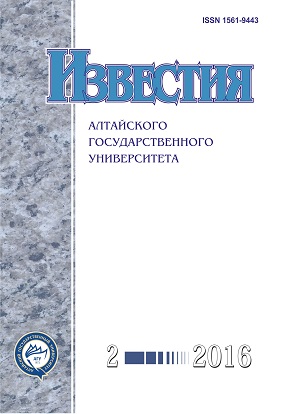Legal Status of the Muslims in the Central Asian Suburbs of the Russian Empire and “Muslim Question” in the System of the Regional Administrating (the Second Half of the 19th — the Beginning of the 20th Century)
Abstract
The article presents the analysis of “Muslim aspect” of Russian religious policy in the Central Asian suburbs and the legal status of the Muslims in this region. Administratively it was a part of two territorial units — Steppe and Turkestan general governorships and was the most populated by the Muslims. However the extent of penetration of dogmas and ceremonies of Islam in daily life and consciousness of the people was different. So, syncretism in religious consciousness — synthesis of the pagan and Muslim norms prevailed mainly among the nomadic people of Steppes and Turkestan: Islamic dominant was prevailing among the settled population of the region. This peculiarity defined the policy of the state in terms of regulation of the development of Islam in the Central Asian national suburbs. So, for “nomadic Islam” at the legislative level the policy directed at restriction of its further distribution among nomads and suppression of their attempts of integration into the all-Russian Muslim movement was pursued. As to the settled Muslim people, the position of the central and regional authorities was reduced to complete ignoring of Islamic institutes with the subsequent stage-by-stage dismantling of the most influential ones. That is why the policy of the state in the sphere of Islam regulation had a restrictive character. The hardest line of the power was in a question of granting to the Muslim population of the Steppe and Turkestan territories to be entitled to have own spiritual department of religious affairs on an example of the Orenburg, Taurian and Caucasian Muslim spiritual meetings. Despite numerous petitions of the population of Central Asia to the government the question was not solved positively up to 1917.
DOI 10.14258/izvasu(2016)2-18
Downloads
Metrics
References
РГИА (Российский государственный исторический архив). - Ф. 821. - Оп. 133. - Д. 603.
Бартольд В.В. Сарт. Сочинения. - М., 1964. - Т. 2. Ч. 2.
Лысенко Ю.А., Тарасова Е.В., Анисимова И.В, Стурова М.В. Традиционное казахское общество в национальной политике Российской империи: концептуальные основы и механизмы реализация (XVIII - начало XX в.). - Барнаул, 2014.
Ремнев А.В. Татары в казахской степи: соратники и соперники Российской империи // Вестник Евразии. - 2006. - № 4.
Батунский М.А. Россия и ислам. Ч. II. - М., 2003.
РГИА. - Ф. 821. - Оп. 8. - Д. 594.
Лысенко Ю.А. Религиозная политика как механизм закрепления имперских позиций России в Туркестанском крае (вторая половина XIX - начало XX в.) // Вестник ТГУ - 2012. - № 4.
Усменова Д. Мусульманские представители в Российском парламенте. 1906-1916 гг. - Казань, 2005.
РГИА. - Ф. 821. - Оп. 11. - Д. 65.
Рыбаков С.Г. Устройство и нужды управления духовными делами мусульман России // Ислам в Российской империи (законодательные акты, описания, статистика) / под ред. Д.Ю. Арапова. - М., 2001.
ЦГА РК (Центральный государственный архив Республики Казахстан). - Ф. 25. - Оп. 1. - Д. 1383.
Султангалиева Г. «Татарская» диаспора и конфессиональные связи казахской степи (XVIII-XIX вв.) // Вестник Евразии. - 2000. - № 4 (11).
Лысенко Ю.А. Вопрос о воинской повинности для казахского населения (70-е гг. XIX - начало XX в.) // Известия Алт. гос. ун-та. - 2012. - № 4/2.
Дамешек Л.М. Сибирские инородцы в имперской стратегии власти // Современное историческое сибиреведение XVII - начала XX вв. : сб. науч. тр. / под ред. Ю.М. Гончарова. - Барнаул, 2005.
ЦГА РК. - Ф. 369. - Оп. 1. - Д. 5845.
Лысенко Ю.А. Развитие исламского общественного движения в Казахстане в начале XX в. и позиция региональных органов власти // Известия Алт. гос. ун-та. - 2013. - № 4/1.
РГИА. - Ф. 821. - Оп. 133. - Д. 613.
Izvestiya of Altai State University is a golden publisher, as we allow self-archiving, but most importantly we are fully transparent about your rights.
Authors may present and discuss their findings ahead of publication: at biological or scientific conferences, on preprint servers, in public databases, and in blogs, wikis, tweets, and other informal communication channels.
Izvestiya of Altai State University allows authors to deposit manuscripts (currently under review or those for intended submission to Izvestiya of Altai State University) in non-commercial, pre-print servers such as ArXiv.
Authors who publish with this journal agree to the following terms:
- Authors retain copyright and grant the journal right of first publication with the work simultaneously licensed under a Creative Commons Attribution License (CC BY 4.0) that allows others to share the work with an acknowledgement of the work's authorship and initial publication in this journal.
- Authors are able to enter into separate, additional contractual arrangements for the non-exclusive distribution of the journal's published version of the work (e.g., post it to an institutional repository or publish it in a book), with an acknowledgement of its initial publication in this journal.
- Authors are permitted and encouraged to post their work online (e.g., in institutional repositories or on their website) prior to and during the submission process, as it can lead to productive exchanges, as well as earlier and greater citation of published work (See The Effect of Open Access).








